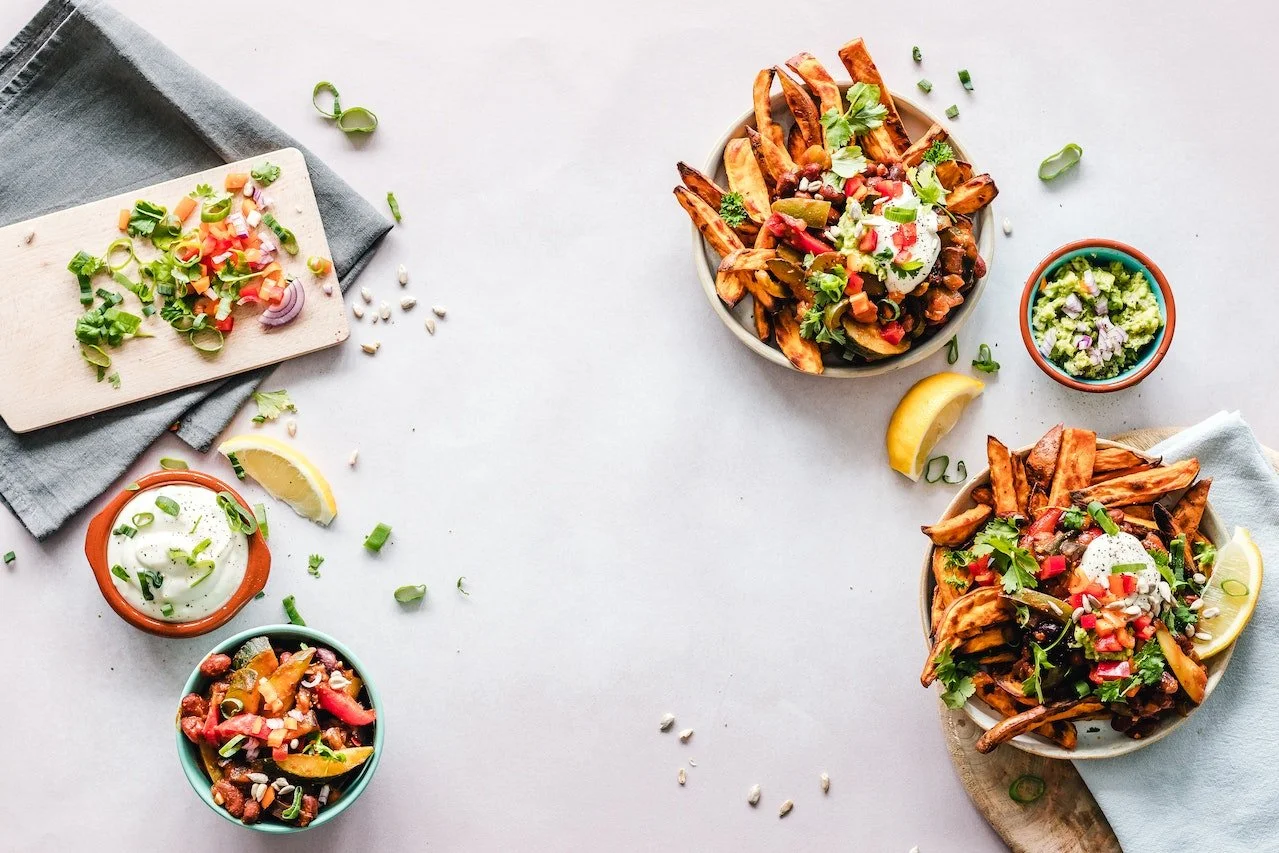The Game Plan for a New Diet
Abstract
The journey begins!! Many personal training clients can quickly adapt a new plan for 2-3 weeks, but it isn’t long-term realistic while challenging a lifetime of wired habits. After years of study, I believe Zafra Cooper’s book Cognitive-Behavioral Treatment for Obesity offers the most comprehensive solution for sustainable weight loss of any level. Hands down.
I also understand that most personal training clients don’t want to dedicate such an intensive effort to therapy, assessment, reflection, experimentation, and analysis, nor do they have the time. Although I have extracted what I believe are the most instrumental activities to achieve your health goals, please know that we are hacking the system in some ways. Truly sustainable change for the more significant habits in life requires a consistent routine with an emotional overlay over 1-12 months. Essentially, we need to lay new neural railroad tracks!
We will attempt to help you reach your goals sooner, though (and I’ve seen it done nearly 20 years of personal training). If you need motivation, check out The Evolution of My Personal Diet or read my personal trainer reviews. The reviews are positive, not because I perform magic-I’m just a guide. My personal training clients (aka all-stars) did the necessary reflection and work to reach their results. Instead, I should be reviewing them: “Emily is the quintessential reflective being and human scientist dedicated to unearthing her movement and eating patterns through collaborative relationships. She has exhibited exemplary control over her health by instituting a cyclical approach of awareness, acceptance, and adaptation.” I believe you can be the next Emily.
So, with this being said, I have constructed the game plan below. It is meant to be self-guided and followed in the given order for reflective reasons and efficacy. You may jump around as needed, though. If you decide to complete the activities and send me your answers, I will certainly send my response with additional insights. We will also discuss your journey during our sessions as well. Whether you’re a meat eater or plant enthusiast, a change in your health will always begin with a change in your mind. It’s time to go beyond the simple and dig into our beautiful, complicated selves.
Keywords
Sustainable weight loss
Cognitive-Behavioral Treatment for Obesity
Wired habits
Neural railroad tracks
Motivation
Immersive experience
Diet plan
Diet log
Dietary changes
Taste and Texture Profile
Emotional Experience with Food
Situational Experiences with Food
Inflammatory foods
Stress eating
Portion control
Foundation of Nutrition
Biological clock
Circadian rhythm
Meal plan
Nutrient ratio
Vegetable intake
Trigger foods
Lean muscle
Creating a new normal
Whole food
Self-improvement books
Nutrition books
OUR GOAL TODAY
Get yourself up and running with this self-guided plan and begin an immersive experience!
PART 1: ESTABLISH THE GAME PLAN
Here's your adaptable game plan for your diet over the next four weeks. Please note that many of the phases will overlap. Jump around as desired, but know it was designed and ordered strategically :).
PHASE 1: Assessing the trends and patterns of you (Week 1)
Assessment Activities:
Activity: Complete a 3-day diet log with times (no caloric amounts needed at first, simply examining current patterns and preferences). You may complete this log in an email, on your phone, or using an app like My Fitness Pal. Find my sample personal trainer log: A Personal Trainer’s 3-Day Diet Log.
Activity: Experiment with several quick and easy dietary changes/pivots (10-20% change). Find resources throughout www.michaelmoodyfitness.com and visit the sites/books mentioned in the Immersive Experience section below.
Activity: Complete the Taste and Texture Profile.
Activity: Complete the Connecting Our Emotional Experience to Food Assessment.
Activity: Complete the Evaluating Our Situational Experiences with Food Assessment (e.g., social settings versus when stressed).
Book: Begin reading the first five chapters of Dr. Fuhrman’s book End of Dieting. Pay special attention to the notes about inflammatory foods and popular diet differences. Also, note the order here. I purposely placed this activity at the end of this section. The awareness of your current patterns is the essential first step. It frames anything else you modify or add to your diet. If you don’t make changes extending from your current habits, you may eventually return to the same wired habits down the road.
Examine Stress Eating and Portion Sizes:
PHASE 2: Laying the foundation of eating (Weeks 1/2)
The Foundation of Nutrition:
Article: Review The Whole Food Plant-Based Pyramid of Nutrition Principles Article and reframe your anchors into a pyramid (not your parent's food pyramid). Please keep in mind that this approach to diets also extends to animal consumption. No matter the amount of meat in your diet, plants must provide a baseline for an optimal strategy.
Article: Review the 10 Phase Diet Progression for Weight Loss and choose your starting point. Reassess and move up or down on the progression list based on your needs, wants, and results every two weeks.
Activity: Begin your self-assessment and foster a new dietary awareness. Ask yourself after each meal, “How did the meal affect me physically, and what steered my choices for this selection?”
Book/Research: Continue reading End of Dieting and review the principles of diet and the science behind digestion and absorption, as well as your biological clock and circadian rhythm provided in the following links:
Research: The Adventist Health Studies
Research: The Iowa Women's Health Study
Research: The Nurses' Health Study
Research: The Physicians' Health Study
Research: Circadian Rhythms and Obesity in Animals
Activity: Begin creating a meal plan based on the insights from the activities above, the links throughout this game plan, Dr. Fuhrman’s suggestions in the book, and the other resources you’ve examined.
Setting Principles and Your Philosophy:
Article: THE WHOLE FOOD PLANT-BASED PYRAMID OF NUTRITION PRINCIPLES
Article: A Personal Trainer’s 3-Day Diet Log (An example of how I've used these principles in my diet)
Book: The Omnivore's Dilemma by Michael Pollan
Book: In Defense of Food by Michael Pollan
Documentary: The Game Changers - The documentary dispels the common misconceptions about nutrition through the lens of the active person. I must emphasize an important point: The principles apply to males and FEMALES.
Documentary: What the Health - An excellent documentary demonstrating the compromised nutritional influences on our lives and the power of a plant-based approach.
Book: The End of Dieting by Dr. Fuhrman
PHASE 3: REVAMPING YOUR DIET AND Testing (Weeks 2/3)
As you add new foods to your diet, determine your body's sensitivity. Pay attention to the environmental and social influences on your behavior. Are separate routines required for these different situations? Have you found new foods you like or dislike? Quite a bit to assess and reassess. Here is a list of significant areas that you’ll want to examine.
Consistency (Average Meal Times):
Important Questions: What time do you typically eat each meal? Does this vary from day to day?
The Lesson: As a goal, you'll want to eat within 30-60 minutes of the same mealtime each day. You typically want to feed yourself every 3-5 hours to minimize any deficiency, control your blood sugar levels, and train your biological clock for a hormonal anticipatory response. If one pushes the limit to 6-9 hours in between meals, it may seriously affect their portion control.
The Big Questions: What determines the amount of time in between meals? Do you typically allow a big gap in between? Is it because you're not hungry or busy with work?
Activity: Time to do a check-in every 3-5 hours.
Book: Eat for Life by Dr. Furhman (The follow-up book to End of Dieting and the non-sensational, scientific explanation of why these principles are so important.)
Article: 6 Breakfast Items at Starbucks that Will Lead to Weight Gain
Article: The 17 Healthiest Breakfast Options from a Diner Menu
Article: "If You're Trying to Lose Weight, Don't Make These 10 Breakfast Mistakes" Review
Article: “5 Ways Your Breakfast is Sabotaging Your Weight Loss” Review
Amount of Food:
Essential Questions: What is the typical amount of food for each meal? What steers the amount? Do you ever feel stuffed or starved?
The Lesson: Did you feel stuffed or starved after any meal? If so, you may want to modify the amount to 25% in either direction. Your body will not operate effectively when deficient or handle a surplus at a given time.
When is your first meal? What time do you typically wake up? Are you starving by this first meal? Eventually, your body may be starved/nutrient deficient and kick in its secondary system (which can compromise weight loss efforts). In the longitudinal study of my personal training clients over the last 15 years, anyone who didn't eat within 1-2 hours of waking up faced the biggest challenges in reaching their goals. Another note: A gram of fat typically is nine calories, while protein and complex carb options are around four. Sometimes, cutting some of the fat to shave a larger and quicker chunk of the meal is easier.
The Big Questions: Ask yourself if you feel stuffed or starved before and after every meal.
Activity: Aim to eat within 1-2 hours of waking up.
Vegetable Intake:
Essential Questions: What is the ratio of nutrients and vegetables on your plate?
The Lesson: The nutrient ratio goal for each plate is 50% vitamins and phytonutrients, 25% fiber, and 25% protein. Where's the good fat? You'll get it with these food choices, but try not to exceed 15%.
The Big Questions: How can we maintain at least a vegetable intake of 50% on each plate during day-to-day, social, and stressful situations? It looks like you have a good start on the day-to-day approach!
Activity: Establish a rigid rule of half a plate of vegetables for every meal (even when eating out socially).
Article: The Grocery List that Will Help You Lose Weight (and Live Healthy)
Article: Macro Grocery List
Book: Cookie and Kate Cookbook (vegan and vegetarian options)
Book: The Minimalist Baker Cookbook (vegan and vegetarian options)
Trigger Foods:
Essential Questions: What are your trigger foods? How does the environment influence these choices?
The Lesson: I don't care if you're the queen of nutrition.....any bagels, pasta, peanut butter, candy, quick bars, or chocolate will even terrorize the strongest (hence why non-animal eaters may still struggle with their health). Healthy or not, I wouldn't keep it in the house if you can't control the amount. For example, Dave's Killer Bread and Ezekiel Sprouted Bread are the healthiest choices. These products offer whole-grain ingredients that give them more value. Considering how whole wheat is grown these days, I'd move this ingredient to the bottom of the list.
A case study to also think about I can eat avocado toast with sliced tomatoes, and TJ's Everything seasoning all day, every day. Luckily, the fats in the avocado offset the blood sugar spike from the bread (which still occurs with the healthiest bread). Overall, though, it may still be too much for my cumulative blood sugar levels (hello, diabetes, and weight gain) and will dangerously increase the amounts of my good fats (which should remain between 12-15% of my daily intake). If you add avocado or seeds to any meal, keep it to two tablespoons to be safe.
Also, peanut butter (or any nut butter) is a notorious trigger food for most. The combination of carbs, fats, and protein is similar to the lethal combination found in a McDonald's hamburger and pizza. Putting aside the fact that it's tough to stop after the recommended serving of 2 tablespoons, oil is quite simply not healthy (the main ingredient in nut butter). Keep in mind that oil is highly processed and a massive smack of nutrient-shallow calories (yes, even EVOO or avocado oil). Although we keep the nut butter in our house for Preston, I don't touch it. It took me years to unsubscribe, though.
Another note about snacks and desserts (chips, donuts, apple pies, cheese bites, etc.). I can pretty much eat 12 lbs of chocolate every day....and a tiny bit begs me to eat more. Instead of wasting my simple sugars on a massive chocolate brownie with caramel (very specific, huh?), I save it for alcohol consumption (Who doesn't like wine?). Remember that excess simple sugar consumption throws your blood sugar levels and weight for a spin. Perhaps find a lower-sugar option (like fruit) as an alternative.
Quick Options (Like Bars):
Essential Questions: Do you ever grab a bar on the run? If so, what's inside your favorite bar?
Your Lesson: It's worth mentioning if this exists on other days. The Larabars RX Bars undoubtedly provide the closest ratio of macronutrients (protein, fat, and fiber) I have found in any quick bar. It's minimally processed and tends to consist of 3-8 whole ingredients (essential since our intent is to include whole plants). Unfortunately, it doesn't supplement the value of a full meal, it's still processed (though minimally), and may contain eggs (whole food plant-based is preferred). I don't worry about the tax you put on your system while eating this bar. I worry about the fuel you're missing with this choice. The fuel needed to sculpt a lean body is under the intensity of exercise 5-6 days per week. We want to "Meet the Need" of our bodies. To clarify, I didn't mean meat. Just something to keep in mind if you're ever in the supplement spirit.
Animal Choices (Including Eggs):
Essential Questions: What are these choices' social, cultural, and environmental influences?
The Lesson: If you live with an animal on your plate, know that it isn't as a nutrient-dense option as beans, seeds, and nuts (among a million other vegetables). My clients who typically consume at least 40% of animal (meat and dairy) in their diets tend to have the most difficulty losing weight and body fat. See Dr. Fuhrman's book Eat for Life if you need science to back up all these suggestions on nutrition and The Game Changers documentary, which dispels the common misconceptions about nutrition through the lens of the active person. I wonder what you can get away with each day. If you want a less inflammatory (nutrient-dense) option, try substituting its calories and protein for seeds, beans, and nuts.
Activity: The more whole food plant-based diets, the more lean muscle and tone you'll achieve. If you choose meat, aim for wild, free-range, and organic. Trader Joe's organic vegetarian eggs with omega-3 are the best option if you buy eggs. Translation: The farmers feed their free-range birds seeds (and free-range is a rather loose term).
Article: Are Eggs Healthy? Learn the Truth (An in-depth and informative perspective)
Book: Eat for Life by Dr. Furhman (Like End of Dieting, this book describes explicitly the negative consequence of too much animal consumption)
Research: Association of Animal and Plant Protein Intake With All-Cause and Cause-Specific Mortality
PHASE 4: Creating a new normal (Weeks 3/4)
Adapt your base meal plan from observations, tests, books, and many resources.
Assess the meal plan every two weeks. This assessment could be as simple as “How can I add a new meal or subtract a meal that makes me feel uncomfortable?”
PART 2: IMMERSE YOURSELF (SOMETHING TO KEEP IN MIND)
You're building a new normal, and it’s time to pull from the multiple resources above and hold yourself accountable. Joining whole food and fitness-related social media groups adds another layer of motivation and accountability, too. Also, you’re more likely to maintain a healthier mindset when you’re consistently reading self-improvement and nutrition books. These books will feed you new information, but the real value is the reminder and the mental structure you maintain while digging in daily. My crazy mind, when tamed, is an incredible force that amplifies the enjoyment of experiences. It drives my endeavors. It could also be a wild beast if not contained. Think about how you want to tame your inner beast with new habits.
ABOUT THE AUTHOR: MICHAEL MOODY, PERSONAL TRAINER
As an author, a personal trainer in Denver, and podcast host, Michael Moody has helped personal training clients achieve new fitness heights and incredible weight loss transformations since 2005. He also produces the wellness podcast "The Elements of Being" and has been featured on NBC, WGN Radio, and PBS.
Michael offers personal training to Denver residents who want to meet at the 2460 W 26th Ave studio….or in their homes throughout LoHi (80206), LoDo (80202), RiNo (80216), Washington Park (80209), Cherry Creek (80206, 80209, 80243, 80246, 80231), and Highlands (80202, 80211, 80212). Michael also offers experiences with a personal trainer in Jefferson Park (80211) and Sloan's Lake (80204, 80212).
If you’re looking for a personal trainer who can curate a sustainable (and adaptable) routine based on your needs and wants, Michael is the experienced practitioner you’ve been looking for. Try personal training for a month…your body will thank you!


































